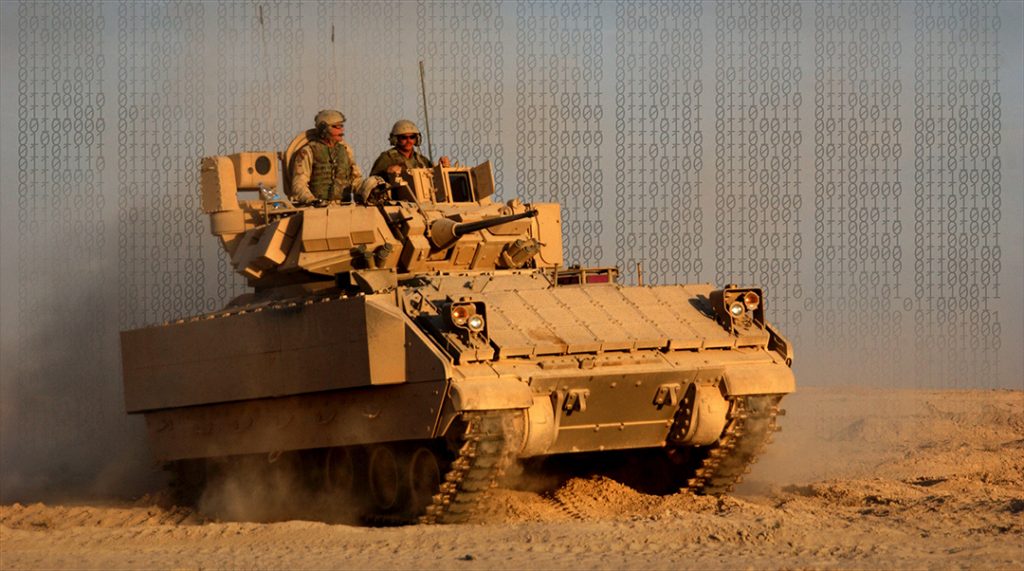
Private Firm to Monitor Combat Vehicle Parts
The U.S. Army has confirmed that it will proceed with a $1 million contract to test the viability of AI to predict when armored vehicle parts will need maintenance, according to sources cited by The Washington Post, which described the move as part of a DoD initiative to procure advanced technologies directly from the private sector.
Offered under contract by Chicago-based AI startup Uptake Technologies, the Army’s new AI prototype will be used to analyze some of the service’s Bradley Fighting Vehicles (BFVs), armored personnel carriers used in combat roles since the vehicle’s adoption by the branch in 1981.
The Army plans to test Uptake’s AI to monitor parts and components of “a few dozen” Bradleys during an initial trial, with hopes that the technology will be able to predict when the vehicles’ myriad parts need maintenance or replacement. A precise, data-driven and proactive approach such as Uptake’s AI could save the service money, time and even lives by better forecasting maintenance needs—before costly and potentially catastrophic failures on the battlefield.
“We’re looking to see if we can leverage some of Uptake’s machine learning algorithms to spot equipment failures before they happen,” Lt. Col. Chris Conley told the Washington Post. The product manager for the Army’s fleet of Bradleys—estimated well into the thousands—Lt. Col. Bradley described the contract as a proof-of-concept:
“I’m not convinced that this will be successful, but I’m really excited about the potential of it […] if this pans out and can provide some real capability, the Army could look to expand this to the entire Bradley fleet as well as other combat vehicle fleets.”
Founded in 2014, Uptake Technologies deploys its sensor and machine learning software across “dozens of sectors around the world,” including fleet management, construction equipment, wind, rail, aviation, and others, according to the company. Uptake’s “purpose-built products ingest and analyze sensor and enterprise data, transforming it into actionable insights and immediate outcomes.”

An example of Uptake’s software at work. Via Uptake.
In perhaps the closest equivalent to the Army’s uses for the technology —monitoring construction machinery —Uptake describes its technology as being able to “reduce equipment downtime [and] flag equipment that needs repair and take proactive measures to avoid breakdowns.”
According to Ganesh Bell, president of Uptake Technologies in the Washington Post, “just like humans have been putting their statuses on Facebook and Twitter, these machines have been putting out their statuses for decades and nobody’s been listening. Only recently do we have the technology to understand that.”
The Army’s contract with Uptake Technologies’ services was born of Defense Innovation Unit Experimental (DIUx), a DoD organization founded in 2015 to accelerate the laborious, time intensive and bloat-prone process of DoD acquisitions by focusing on fast-tracking high-tech private sector solutions for the military’s needs.
Similar in aim to the DoD’s more AI-centric Project Maven which sought to streamline military acquisition of private and academic AI talent—including in drone surveillance using open-source Google APIs, a public relations disaster—DIUx seeks to work directly with private innovators to find promising prototypes and solutions “in a variety of areas—from autonomy and AI to human systems, IT, and space,” according to DIUx.
In contrast to more traditional and slow-moving DoD contracting processes which often take years and sometimes result in technologies that risk obsolescence by the time they are fielded, DIUx finds and pilots advanced private sector proposals at a comparatively blistering pace–“usually in under 90 days”, according to the project.
Headquartered in Mountain View within a smartphone’s throw of other tech-centric Silicon Valley organizations, and with offices near other tech development hubs, DIUx has garnered an impressive portfolio of up-and-coming tech companies in AI, IoT, cybersecurity and drones as well as contracts with existing tech mavens such as Palantir and Raytheon.
Former chairman of the Joint Chiefs of Staff and retired U.S. Navy Adm. Mike Mullen sees “huge potential […] for better outcomes and a lot less expense” in Uptake’s pilot, according to the Post. Adm. Mullen says the military maintains a costly “almost wait for failure and then figure it out” approach to maintenance, whereas the Uptake AI—if successful—“will give you much better information on what your maintenance system should be. It allows you to be precisely predictive on when a part is going to fail, when a component is going to fail, when the whole system is going to fail.”
The Army recently purchased 473 new Bradleys—what defense blog We Are the Mighty called a “ridiculous” number—from BAE Systems in an effort to expand the Army’s ground warfare capabilities against conventional adversaries such as Russia and China and future-proof the vehicles, but the bulk of the service’s Bradleys and other primary vehicles are decades-old and in increasing need of costly retrofitting programs and repairs, a concern that the Uptake pilot might address if ultimately adopted by the military.







Leave A Comment